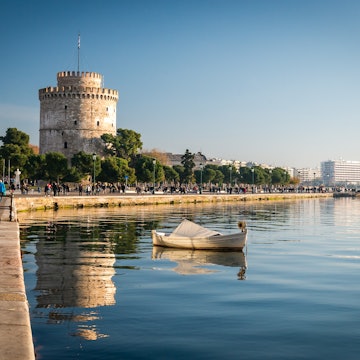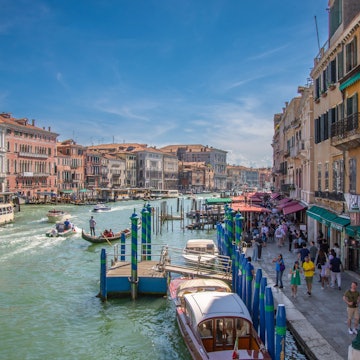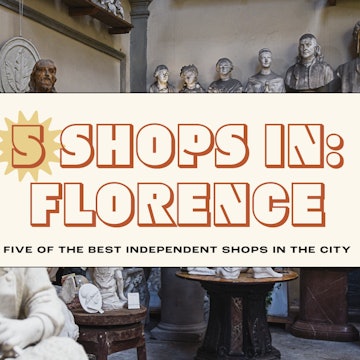
Florence vs Venice: how to choose between two Italian icons



If you could only visit Florence or Venice, which would it be? Our writers can help you decide © iStock
Only got time for a visit to one beautiful Italian city?
Home to some of the world's greatest art, architecture and food, it can be incredibly hard to choose where to spend your time in Italy. How does anyone decide between Florence, the cradle of the Renaissance, and Venice, a city of marble palaces floating on a lagoon?
Should you be the unlucky soul that needs to make that decision, our Lonely Planet writers are here to help, each putting forward their case for why their favorite city should be your top choice too.

Florence is a Renaissance wonder
Lonely Planet Italy expert for two decades, Nicola Williams wrote the most recent edition of Lonely Planet’s Pocket Florence & Tuscany guidebook.
Let’s cut to the chase. Maybe I should encourage you to head elsewhere given the near-permanent crowd that fills Florence to bursting. In 2023 the number of visitors at the Uffizi hit yet another new, all-time high of 5 million (smashing the previous record of 4.3 million in 2019).
But when you see 6000 mother-of-pearl shells encrusting the ceiling of the Medici’s sumptuous treasure-chest Tribune, two rooms of Botticelli masterpieces and the world’s largest collection of Italian Renaissance art, it’s easy to understand why. The artistic beauty and sensorial thrill of Florence is intense, soul-stirring and thrillingly sublime: think goose pimple stuff that everyone should experience at least once.
What makes the Tuscan capital extra special is its Renaissance wonder. Imagine a place where allegorical statues of the Four Seasons dating to 1608 nonchalantly stand sentry on one of the bridges across the Arno; where Giambologna’s powerful Rape of the Sabine Women (1582) kicks you in the gut in an open-air loggia on historic main square Piazza della Signoria; where utterly heavenly medallions of swaddled babes by Andrea della Robbia (1435–1525) adorn the facade of an old orphanage-turned-museum in the San Marco university district.
Yes, Florence’s flush of museums and monuments is world-class. Yet you don’t actually need to step foot in a single one to be bowled over by ethereal masterpieces. This said, please do eyeball Michelangelo’s David close up at Galleria dell’Accademia, swoon over the achingly beautiful Pietà, which the Renaissance master sculpted aged 80 for his own tomb in Museo dell’Opera del Duomo, and risk losing your mind over his haunting Night, Day, Dawn and Dusk sculptures in the jewel-caked Medici chapels where 49 members of Florence’s infamous Medici clan are buried.

Admittedly Venice’s cathedral is not too shabby, but the unforgettable majesty at Florence’s iconic Duomo are on an entirely different scale. Brunelleschi’s brick-red cathedral cupola has been a feature of the city’s skyline since 1436, and the trek up 463 steep stone steps inside his Herculean dome – the largest to be built since antiquity – is dizzying. Ditto for the insanely close-up views halfway up of 16th-century Last Judgement frescoes swirling across the 4500-sq-meter (48,438-sq-ft) cupola and, when you finally alight breathless at the top, the 360° view of this beautiful Renaissance city is laid out beneath you.
And if you really insist on glittering gold mosaics Venice-style, duck into the octagonal baptistry for a priceless guided tour of its 1037-sq-meter (11,162-sq-ft) ceiling mosaic, under restoration until 2030. Climb into the vault, glimpse craftspeople at work and try not to let your jaw drop to the floor: you will most likely never get this close again to pixelated biblical scenes cut in a shimmering rainbow of white Carrara marble, green serpentine, salmon-pink coral and other richly colored, precious stone by the finest mosaic artisans in 13th- and 14th-century Europe.

I’ve spent weeks at a time in Florence most years for the past two decades – as a singleton, with a babe in arms, with three highly energetic bambini and later with teens. Compact and highly walkable, the city entertains families with so much more than art: abundant parks, towers to climb, hands-on science, miniature trains, Da Vinci flying machines, gelato tours, rafting on the Arno, a day trip by train to Pisa’s Leaning Tower.
The mind-blowing collection of 18th-century botanical and human anatomy wax models, skeletons and taxidermy animals at the natural-history museum La Specola or the subterranean digital art in a recycled WWII bunker at Rifugio Digitale are two brilliant examples of the unexpected whimsies this traditional Italian city, with bags of contemporary sass, also throws up.
Then there’s la cucina. Sea-faring Venice might seduce with fish and miniature razor clams from the lagoon, but Florence trumps again with its cuisine including blue bistecca Fiorentina (T-bone steak), dare-devil tripe, red wines bursting with sunshine and aphrodisiac black truffles from the Tuscan countryside. With farm-to-table trattorias and palazzo restaurants serving dishes like artworks, just be warned: the risk of a dizzying spell of Stendhal (or Florence) syndrome, is very real. Google it.

Venice is the city of floating dreams
Kerry Walker’s first Italian love as a child was Venice. She has been drawn back to this enchanting island-speckled city time and again over three decades, and has co-authored the Lonely Planet Italy guide.
I first saw Venice as an eight-year-old child. I remember being enthralled by how the city rose above a maze of mirror-like canals, like something plucked from a Canaletto painting (not that I knew who Canaletto was back then!). My memories of that summer trip return like fragments of a dream: green shutters being thrown open to let the light spill in, echoing footsteps across Piazza San Marco, giggles at pigeons landing on heads, the rainbow glimmer of Murano glass, the operatic warbles of gondoliers in striped T-shirts and straw boaters, thunderstorms that rattled windows.
Years later on post-grad travels around Europe, I took an overnight ferry from Greece to Venice, docking in the rose-gold dawn of a September morning, just as the first rays touched the city’s great domes and spires. When you arrive by boat across the Adriatic, you really appreciate how Venice is defined, shaped and built upon water. It is a masterstroke of human brilliance: a city floating above a muddy lagoon like froth on a cappuccino. And the fact it is slowly sinking just adds to its mystery, its transient allure.
To really feel the pulse of golden-age Venice, embrace the out-of-hours city. Walk its labyrinthine, canal-woven streets at daybreak as the city shakes off sleep and the first espresso makers start bubbling. Or explore the passageways and narrow calli (alleys) of the six historic sestieri (districts) in the dusky blue hour, as lanterns cast reflections in the canals and softly illuminate palazzi (mansions). Slip away from the masses and tourist tat kiosks and dive into the old Jewish quarter, Ghetto, for quiet lanes and synagogues. Or skip the pricey gondolas and see the city from a new water-level perspective night paddling with Venice Kayak.
July and August are madness – visit in more peaceful spring, autumn or winter, when Venice has a romance Florence can never match. Ultra-low season is the time for ticking off big-hitters like the graceful Renaissance arch of Ponte di Rialto, the spectacularly domed Byzantine Basilica di San Marco and its glittering feast of mosaics, and the Gothic swagger of the Palazzo Ducale, a lacy pink-and-white marble confection that was once the doge’s digs. And when Venice almost subsides under the weight of summer crowds, get the hell out of San Marco.

You could boat it across to one of Venice's islands, for starters. A quick vaporetto (water bus) ride north of the center, Murano captivates with the artistry and alchemy of its glass-blowing workshops. Further north, Burano is Instagram eye-candy with its brilliant array of brightly colored houses, and its Museo del Merletto shows off the exquisite lace that was all the rage amongst European aristocrats in the 17th century. But my favorite is its quieter neighbour, Torcello, whose 7th-century Byzantine-Romanesque Basilica di Santa Maria Assunta, Venice’s oldest church, will leave you speechless with mosaics offering a golden glimpse of heaven.
You might think Florence wins on art – and there’s no denying those Michelangelos in the Uffizi are amazing – but Venice is a worthy rival. This is the city, after all, where Renaissance superstars like Titian, Tintoretto and Veronese showed off in the 16th century (their masterpieces hang in the unmissable Gallerie dell'Accademia). I also love the Peggy Guggenheim Collection, a canalside 18th-century palazzo with a phenomenal stash of abstract, futurist and expressionist art, including works by Picasso, Max Ernst and Dalí, among many others. And Ca’ Pesaro delivers an incredible hit of modern art in a gorgeous baroque marble palace.
And when it comes to festivals, Florence simply can’t compete. Venice has theater, music and drama in its blood. The Biennale, which floods the city with standout art and architecture for six months of the year, and the all-out parties and flamboyant masked balls of the pre-Lenten Carnevale di Venezia are just the icing on the cake.

As for Venice’s food scene? It’s right up there with Italy’s best and worth planning a trip around in its own right. Seasonal flavors sing in the likes of risotto al nero di seppia (squid ink risotto), market-fresh lagoon fish and violetti di Sant'Erasmo (tender purple baby artichokes). Track down a bàcari (wine bar), where outstanding Veneto wines (from Prosecco to velvety Amarone reds) are paired with cicchetti (Venetian tapas) like calamaretti alla piastra (griddled baby squid), polpette (meatballs) and baccalà mantecato (creamed salt cod), each one a glorious mouthful. Or else go all out at top tables like two-Michelin-starred Enrico Bartolini, culinary time traveler Bistrot de Venise and delightful family-run osteria Anice Stellato.
Florence will touch you with its beauty, no doubt, but Venice is the whole dolce vita package: a joyous swirl of romantic canals and islands, architecture and art, festivals and food. Once you’ve visited, you’ll long to return to this city of floating dreams, because there is just nowhere on earth quite like it.















